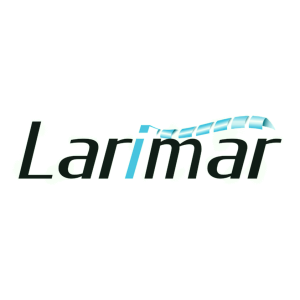Larimar Therapeutics Reports Positive Top-line Data from Phase 2 Dose Exploration Study from 25 mg and 50 mg Cohorts of Nomlabofusp in Patients with Friedreich’s Ataxia
- Nomlabofusp was generally well tolerated following repeated subcutaneous injections in patients in the 25 and 50 mg cohorts with no serious adverse events
- Dose dependent increases in frataxin levels were observed in skin and buccal cells
- Open Label Extension (OLE) study initiated in January 2024 to dose 25 mg daily of nomlabofusp with dosing anticipated to be starting later this quarter; Initial data expected in Q4 2024
- Initiated discussions with the FDA on use of tissue frataxin levels as a novel surrogate endpoint to support a potential Biologics License Application (“BLA”) submission for accelerated approval targeted for 2H 2025
- Company management to host webcast and conference call today at 8:00 a.m. ET
BALA CYNWYD, Pa., Feb. 12, 2024 (GLOBE NEWSWIRE) -- Larimar Therapeutics, Inc. (“Larimar”) (Nasdaq: LRMR), a clinical-stage biotechnology company focused on developing treatments for complex rare diseases, today announced positive top-line data and successful completion of its four-week, placebo-controlled Phase 2 dose exploration study of nomlabofusp (CTI-1601) in participants with Friedreich’s ataxia (FA). Nomlabofusp was generally well tolerated and demonstrated dose dependent increases in frataxin (FXN) levels in all evaluated tissues (skin and buccal cells) after daily dosing of 14 days followed by every other day dosing until day 28 in the 25 mg and 50 mg cohorts. Participants in the 25 mg (n=13) and 50 mg (n=15) cohorts were randomized 2:1 to receive subcutaneous injections of nomlabofusp or placebo.
“We believe the dose-response and increases in FXN levels seen in peripheral tissues further reinforce the therapeutic potential of nomlabofusp to address FXN deficiency, the known root cause of disease in patients with FA,” said Carole Ben-Maimon, MD, President, and Chief Executive Officer of Larimar. “Importantly, the patients treated with 50 mg of nomlabofusp presented with individual baseline FXN skin levels less than
Dr. Ben-Maimon continued, “Recently, we had discussions with the FDA regarding the use of tissue FXN levels as a novel surrogate endpoint. The FDA has acknowledged that frataxin deficiency appears to be critical to the pathogenic mechanism of FA, and that there continues to be an unmet need for treatments for FA patients that address the underlying disease pathophysiology. We intend to pursue an accelerated approval using FXN levels, supportive pharmacodynamics and clinical information, and safety data from the OLE study, along with additional nonclinical pharmacology information needed to support the novel surrogate endpoint approach. We are beginning to plan for a confirmatory study and are targeting a BLA submission in the second half of 2025.”
Dr. Russell Clayton, Chief Medical Officer of Larimar added, “These promising Phase 2 dose exploration data further expand our nomlabofusp safety database and strengthen clinical support for the generally well tolerated profile and low discontinuation rates seen across studies. In January, we initiated the OLE study that will start with a 25 mg daily dose, and the first subjects will begin self-administration later this quarter. The OLE study will inform on the long-term safety and self-administration of nomlabofusp following daily subcutaneous administration. Further dose expansion in the OLE will be considered based on safety, pharmacokinetics, and tissue FXN levels from the 25 mg dose of nomlabofusp. We expect to provide interim data from the OLE study in the fourth quarter of 2024.”
Key Phase 2 Results
- Median changes in FXN levels from baseline for the 25 mg and 50 mg cohorts of nomlabofusp
- Skin cells: 2.81 pg/µg for the 25 mg cohort and 5.57 pg/µg for the 50 mg cohort
- Buccal cells: 0.56 pg/µg for the 25 mg cohort and 0.72 pg/µg for the 50 mg cohort
- As seen in our multiple ascending dose (MAD) study, when dosing is switched to every other day, FXN levels decline from the levels achieved with daily dosing but remain above baseline.
- All treated patients demonstrated increases in FXN levels in skin cells and the majority of patients also demonstrated increases in FXN levels in buccal cells.
- At Day 14, all patients with quantifiable levels at baseline and Day 14 treated with 50 mg of nomlabofusp achieved FXN levels in skin cells greater than
33% of the average level found in healthy volunteers, and 3 of the patients achieved levels greater than50% of the average healthy volunteer level. - While FXN levels measured in buccal cells show a high degree of correlation with FXN levels measured in skin cells, higher variability in FXN levels was seen in buccal cells compared to skin cells in both the multiple ascending dose study and the Phase 2 dose exploration study. Skin cells have a lower turnover rate and skin is a more stable tissue. The collection method for skin cells is also well-established and standardized, which provides a more reliable and reproducible measure of changes in FXN levels with treatment compared to buccal cells.
Median baseline tissue FXN levels in skin cells were 3.70 pg/µg and 2.12 pg/µg for the 25 mg and 50 mg cohorts, respectively, and in buccal cells were 1.78 pg/µg and 1.61 pg/µg for the 25 mg and 50 mg cohorts, respectively. Changes in FXN levels after nomlabofusp administration in the Phase 2 trial at day 14 (QD: once daily for 14 days) and day 28 (QOD: every other day after day 14) are:
| Median Change from Baseline in FXN Levels (pg FXN/ μg total protein) (25th, 75th percentile) | |||
| Placebo N= 9 | 25 mg Nomlabofusp N= 9 | 50 mg Nomlabofusp N = 10 | |
| Skin Biopsies* | |||
| Day 14 QD | -0.53 (-0.96, 0.57) | 2.81 (2.16, 3.32) | 5.57 (4.25, 6.55) |
| Day 28 QOD | -0.34 (-0.74, 0.31) | 2.28 (-0.03, 2.71) | 3.14 (2.50, 3.64) |
| Buccal Cells** | |||
| Day 14 QD | -0.35 (-0.75, 0.04) | 0.56 (-0.28, 0.64) | 0.72 (0.05, 1.06) |
| Day 28 QOD | -0.52 (-1.07, 0.01) | 0.03 (-0.66, 0.86) | 0.48 (-0.16, 0.76) |
*Subjects who had one or more FXN measurements below quantifiable levels are excluded from the above analysis.
For the placebo group, one participant had skin cell FXN levels below quantifiable levels on day 14 and day 28. For the 25 mg group, Day 14 and 28 skin biopsies were not collected from one nomlabofusp treated participant who discontinued treatment and one nomlabofusp treated participant had FXN levels below quantifiable levels at day 14 and day 28. For the 50 mg group, one participant had skin cell FXN levels below quantifiable levels at baseline.
**Subjects who had one or more FXN measurements below quantifiable levels are excluded from the above analysis. For the placebo group, one participant had buccal cell FXN levels below quantifiable levels at baseline and four participants had buccal cell FXN levels below quantifiable levels at day 14 and day 28. For 25 mg group, day 28 buccal FXN were not collected from one participant who discontinued treatment and two participants had buccal FXN levels below quantifiable levels at baseline. For the 50 mg, one participant had buccal cell FXN levels below quantifiable levels at baseline, day 14 and day 28, and two participants had buccal FXN levels below quantifiable levels at day 14 and day 28.
Key Phase 2 Pharmacokinetic and Safety Data for 25 mg and 50 mg Cohorts of Nomlabofusp
- Quick absorption after subcutaneous administration of nomlabofusp with dose proportional increases in exposure were observed with increasing doses.
- Generally well tolerated with no serious adverse events reported.
- No severe adverse events in the 50 mg cohort. One severe adverse event for an allergic reaction to the study drug was reported in the 25 mg cohort and was resolved with standard treatment.
- 18 of the 19 participants dosed with nomlabofusp completed the trial, with one participant in the 25 mg cohort withdrawing due to the aforementioned allergic reaction that resolved with standard treatment.
- Most common adverse events were mild and moderate injection site reactions.
Updates on the Nomlabofusp Regulatory Pathway in FA
- FDA acknowledgment that frataxin deficiency appears to be critical to the pathogenic mechanism of FA, and that there continues to be an unmet need for treatments for FA patients that address the underlying disease pathophysiology.
- Ongoing discussions with the FDA on evidence needed to support an accelerated approval application, including supplementary nonclinical pharmacology investigations, FXN, supportive PD and clinical outcomes information from the OLE study, and additional clinical safety data.
- Initiation of a confirmatory study planned prior to BLA submission.
- Potential BLA submission targeted for 2H 2025.
Cash position
As of December 31, 2023, the Company had cash, cash equivalents and marketable securities totaling
Conference Call and Webcast
Larimar will host a conference call and webcast today, February 12, 2024 at 8:00 a.m. ET. To access the webcast, please visit this link to the event. To participate by phone, please dial 1-877-407-9716 (domestic) or 1-201-493-6779 (international) and refer to conference ID 13744180, or click on this link and request a return call. Following the live event, an archived webcast will be available on the “Events & Presentations” page of the Larimar website.
About Nomlabofusp (CTI-1601)
Nomlabofusp is a recombinant fusion protein intended to deliver human frataxin to the mitochondria of patients with Friedreich’s ataxia who are unable to produce enough of this essential protein. Nomlabofusp has been granted Rare Pediatric Disease designation, Fast Track designation and Orphan Drug designation by the U.S. Food and Drug Administration (FDA), Orphan Drug Designation by the European Commission, and a PRIME designation by the European Medicines Agency.
About Larimar Therapeutics
Larimar Therapeutics, Inc. (Nasdaq: LRMR), is a clinical-stage biotechnology company focused on developing treatments for complex rare diseases. Larimar’s lead compound, nomlabofusp (CTI-1601), is being developed as a potential treatment for Friedreich's ataxia. Larimar also plans to use its intracellular delivery platform to design other fusion proteins to target additional rare diseases characterized by deficiencies in intracellular bioactive compounds. For more information, please visit: https://larimartx.com.
Forward-Looking Statements
This press release contains forward-looking statements that are based on Larimar’s management’s beliefs and assumptions and on information currently available to management. All statements contained in this release other than statements of historical fact are forward-looking statements, including but not limited to statements regarding Larimar’s ability to develop and commercialize nomlabofusp (also known as CTI-1601) and other planned product candidates, Larimar’s planned research and development efforts, including the timing of its nomlabofusp clinical trials, interactions with the FDA and overall development plan and other matters regarding Larimar’s business strategies, ability to raise capital, use of capital, results of operations and financial position, and plans and objectives for future operations.
In some cases, you can identify forward-looking statements by the words “may,” “will,” “could,” “would,” “should,” “expect,” “intend,” “plan,” “anticipate,” “believe,” “estimate,” “predict,” “project,” “potential,” “continue,” “ongoing” or the negative of these terms or other comparable terminology, although not all forward-looking statements contain these words. These statements involve risks, uncertainties and other factors that may cause actual results, performance, or achievements to be materially different from the information expressed or implied by these forward-looking statements. These risks, uncertainties and other factors include, among others, the success, cost and timing of Larimar’s product development activities, nonclinical studies and clinical trials, including nomlabofusp clinical milestones and continued interactions with the FDA; that preliminary clinical trial results may differ from final clinical trial results, that earlier non-clinical and clinical data and testing of nomlabofusp may not be predictive of the results or success of later clinical trials, and assessments; that the FDA may not ultimately agree with Larimar’s nomlabofusp development strategy; the potential impact of public health crises on Larimar’s future clinical trials, manufacturing, regulatory, nonclinical study timelines and operations, and general economic conditions; Larimar’s ability and the ability of third-party manufacturers Larimar engages, to optimize and scale nomlabofusp’s manufacturing process; Larimar’s ability to obtain regulatory approvals for nomlabofusp and future product candidates; Larimar’s ability to develop sales and marketing capabilities, whether alone or with potential future collaborators, and to successfully commercialize any approved product candidates; Larimar’s ability to raise the necessary capital to conduct its product development activities; and other risks described in the filings made by Larimar with the Securities and Exchange Commission (SEC), including but not limited to Larimar’s periodic reports, including the annual report on Form 10-K, quarterly reports on Form 10-Q and current reports on Form 8-K, filed with or furnished to the SEC and available at www.sec.gov. These forward-looking statements are based on a combination of facts and factors currently known by Larimar and its projections of the future, about which it cannot be certain. As a result, the forward-looking statements may not prove to be accurate. The forward-looking statements in this press release represent Larimar’s management’s views only as of the date hereof. Larimar undertakes no obligation to update any forward-looking statements for any reason, except as required by law.
Investor Contact:
Joyce Allaire
LifeSci Advisors
jallaire@lifesciadvisors.com
(212) 915-2569
Company Contact:
Michael Celano
Chief Financial Officer
mcelano@larimartx.com
(484) 414-2715









